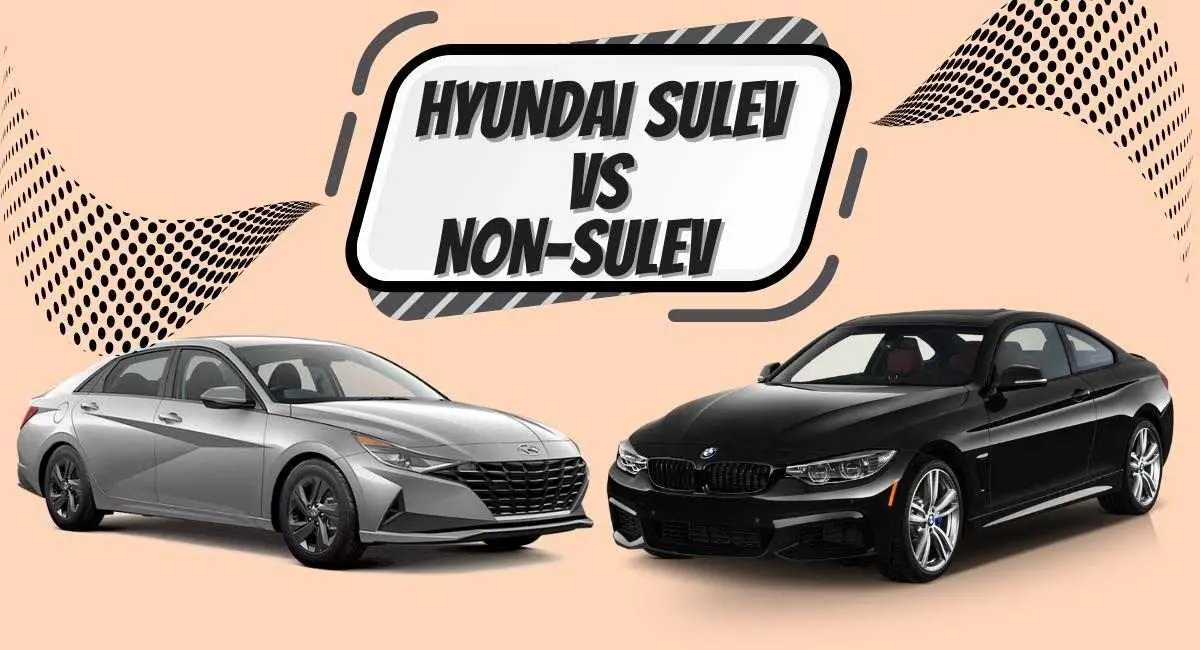When choosing a vehicle, especially in an era where environmental consciousness is on the rise, the choice between Hyundai SULEV (Super Ultra Low Emission Vehicle) and non-SULEV models is becoming increasingly important. This decision isn’t just about the make and model of the car; it’s about the environmental impact, fuel efficiency, and long-term cost of ownership.
The difference between Hyundai SULEV and non-SULEV vehicles is the level of emissions compliance and the associated technology used to achieve it. SULEV vehicles have a design that makes them significantly cleaner in emissions, making them a more environmentally friendly choice.
In this article, we will look into:
- Understanding Hyundai SULEV
- How do I identify whether my Hyundai Elantra is SULEV and identify Hyundai models that are SULEV?
- The differences between Hyundai SULEV and non-SULEV vehicles
- Exploring the SULEV technology
- A discussion on the pros and cons of SULEV technology and
- Helping you decide whether SULEV is the right choice.
Understanding Hyundai SULEV
In this section, you’ll get to know the Hyundai SULEV meaning and understand standards on emissions other than SULEV.
The Hyundai SULEV is a category of vehicles produced by Hyundai that meet stringent emissions standards set by regulatory authorities. These standards aim to reduce harmful tailpipe emissions and minimize vehicles’ environmental impact.
You must know that SULEV is not unique to Hyundai; it’s a classification used by various automakers to denote cars with exceptionally low emissions. This concept began with the United States Environmental Protection Agency (EPA), which introduced several standards to categorize vehicles that adhere to specific emissions standards.
These standards include Low Emissions Vehicle (LEV), the vehicle’s baseline emissions classification. Ultra-Low Emissions Vehicle (ULEV) design emits even fewer pollutants than LEVs.
On the other hand, the Super Ultra Low Emissions Vehicle (SULEV) is an even stricter emissions classification. SULEV vehicles use advanced emissions control technology and highly efficient engine designs to minimize tailpipe emissions.
However, it’s important to note that they fall short of the more stringent standards imposed by the PZEV (Partial Zero Emissions Vehicle) and Zero Emissions Vehicle (ZEV) classifications. For instance, the PZEVs meet SULEV emissions standards and have a zero evaporative emissions requirement, meaning they emit almost no emissions into the atmosphere.
Moreover, the Zero Emissions Vehicle (ZEVs) are the cleanest classification, with no tailpipe emissions. They are typically electric vehicles (EVs) or hydrogen fuel cell vehicles that produce zero tailpipe pollutants.

How to Identify Whether My Hyundai Elantra is a SULEV or ULEV
To determine if your Hyundai Elantra is a SULEV (Super Ultra Low Emission Vehicle), follow these steps:
- Locate the Bank 1 O2 sensor harness. This sensor is near the cylinder head at the top of the exhaust manifold.
- Unplug the O2 sensor harness from its connector.
- Examine the connector closely. If it has 6 pins, your Hyundai has a SULEV 2.0 engine. If it has 4 pins, you have a ULEV (Ultra-Low Emissions Vehicle) regardless of the transmission type.
Remember that the number of pins in the O2 sensor connector is a reliable indicator of the vehicle’s emission classification. In this case, a 6-pin connector signifies a SULEV engine, while a 4-pin connector indicates a ULEV engine.
This method allows you to quickly identify the emission standard of your Hyundai Elantra without the need for additional diagnostic tools or extensive research. Still, it is wise to check with your car dealer to help you quickly identify a Hyundai SULEV.
What Are Other Hyundai SULEV Certified Vehicles?
Hyundai, like many other automakers, offers a range of SULEV-certified vehicles. These vehicles’ designs minimize harmful tailpipe emissions, making them more environmentally friendly and reducing their impact on air quality.
With the vast collection of Hyundai cars, you may need help finding an SULEV-certified car. So, we’ve provided a list of SULEV-certified vehicles to make your work easier.
You can check out specific Elantra models, such as the Elantra Eco, available in SULEV versions. Also, some versions of the Hyundai Sonata, including hybrid variants, have been offered with SULEV certification.
The Hyundai Tucson has had SULEV-certified models available, particularly in hybrid or fuel-efficient versions. But you want a plug-in hybrid and electric variants. In that case, the Hyundai Ioniq, known for this, often comes in SULEV versions due to its focus on fuel efficiency and emissions reduction.
Specific Hyundai Santa Fe models come in SULEV configurations depending on the engine and trim. And like Santa Fe, the Hyundai Kona has been available with SULEV certification for specific engine options.
How Does SULEV Technology Work?
SULEV vehicles achieve their low emission levels through advanced technology. They typically incorporate several features, including:
- An advanced Engine Design. SULEV engines are designed with precision to burn fuel more efficiently, reducing the production of harmful emissions.
- These vehicles often include advanced catalytic converters that reduce emissions by converting pollutants into less harmful substances.
- The quality of fuel plays a significant role, and the presence of low-sulfur gasoline is crucial for achieving these standards. Consequently, certain vehicles may qualify as SULEV in one state while not meeting the same criteria in another due to variations in gasoline refinement levels. Besides, SULEV cars have enhanced fuel Systems. These specialized fuel systems and injectors ensure optimal fuel combustion.
- Onboard Diagnostics: SULEV vehicles have advanced diagnostic systems that continuously monitor the engine’s performance to ensure emissions remain within the mandated limits.
How is SULEV Different from Non-SULEV?
The differences between Hyundai SULEV and non-SULEV cars primarily revolve around emissions standards, environmental impact, technology, cost, and potential incentives. Here’s a detailed breakdown of these differences:
Emissions Standards
SULEV vehicles adhere to stringent emissions standards, emitting significantly fewer harmful pollutants into the atmosphere. Their design minimizes their environmental impact and improves air quality.
On the other hand, non-SULEV vehicles typically meet standard emissions regulations but may emit higher levels of pollutants than SULEV vehicles.
Environmental Impact
With the advanced technology, SULEV cars have a lower environmental impact as they emit fewer pollutants. They contribute to cleaner air and align with efforts to combat climate change.
Conversely, with minimal measures considered, non-SULEV cars have a comparatively higher environmental impact due to higher emissions levels.
Emissions Control Technology
To achieve low emissions, SULEV vehicles incorporate advanced emissions control technology, including precision-engineered components and catalytic converters.
However, you will experience higher emissions with non-SULEV vehicles, which may have less advanced emissions control systems.
Cost
As you decide to purchase, you’ll realize a higher upfront cost for SULEV vehicles. It should not deter you from proceeding with your purchase. It is clear that Hyundai SULEVs are made of advanced emissions control technology and engineering required to meet stringent standards—and this is expensive! But, non-SULEV vehicles generally have a lower initial purchase price.
Fuel Efficiency
Fuel efficiency is at the core of environmental protection and conservation. So, SULEV technology correlates with improved fuel efficiency, potentially leading to long-term cost savings on fuel expenses.
Nevertheless, you’ll notice that non-SULEV vehicles may have varying levels of fuel efficiency, depending on the specific model and technology used.
Incentives
Some regions offer incentives and tax breaks for SULEV vehicle owners to motivate car users to make environmentally conscious decisions, which can offset the higher initial cost.
Non-SULEV vehicles may not qualify for the same incentives as SULEV or cleaner vehicles.
Maintenance and Repairs
Due to their advanced emissions control systems, SULEV vehicles may require more specialized maintenance and potentially more expensive repairs.
Non-SULEV vehicles may have less complex emissions systems, which could result in lower maintenance costs.
Model Availability
Not all Hyundai models are available with SULEV technology, limiting choices for consumers who want an environmentally friendly option. Non-SULEV models encompass a broader range of Hyundai vehicles, providing more picks for consumers.
Pros and Cons of Hyundai SULEV
Pros:
SULEV vehicles significantly reduce harmful emissions, contributing to cleaner air and a healthier environment. It is especially crucial in densely populated urban areas where air quality is a significant concern.
Some regions offer incentives and tax breaks for SULEV vehicle owners. Additionally, the increased fuel efficiency of SULEV cars can lead to long-term cost savings on fuel expenses.
SULEV technology helps lower carbon dioxide (CO2) emissions, contributing to climate change. It aligns with global efforts to combat climate change and reduce greenhouse gas emissions.
SULEV vehicles may have higher resale values due to their environmentally friendly status and potential long-term cost savings for future owners.
Cons:
Due to the advanced technology and emissions control systems, SULEV vehicles often have a higher initial purchase price than non-SULEV counterparts.
SULEV vehicles’ specialized components and technology may require more expensive maintenance and repairs, which can offset some fuel savings.
Not all Hyundai models are available with SULEV technology, limiting your choices if you want an environmentally friendly option.
Is SULEV Good or Bad?
Whether SULEV is a good or bad choice depends on your circumstances and priorities.
So, if you are passionate about reducing your carbon footprint and minimizing air pollution, a SULEV vehicle is a good choice.
Are you working with a flexible budget and are willing to invest in a cleaner and more environmentally friendly vehicle? SULEV can be a positive choice. But if you’re on a fixed budget, you may want to reconsider your choice and avoid spending what you don’t have.
However, keep pursuing your dream car. While SULEV vehicles may have a higher upfront cost, they can offer long-term savings through reduced fuel consumption and potential tax incentives. Therefore, you may have to spend some more now but enjoy cheaper fuel, which is a big deal.
Check if your desired Hyundai model is available as a SULEV variant. If not, you may need to consider a non-SULEV model. And be prepared for potential higher maintenance costs associated with SULEV technology.
Conclusion
Choosing a Hyundai SULEV and a non-SULEV vehicle depends on your priorities, budget, and environmental concerns. SULEV technology offers numerous benefits, including reduced emissions and potential cost savings, but it may come with higher upfront costs and maintenance expenses. Evaluate your needs and preferences to determine which option best aligns with your values and lifestyle. Whether you opt for a SULEV or non-SULEV Hyundai, the important thing is to make an informed choice that suits your unique circumstances and contributes to a cleaner, more sustainable future.
